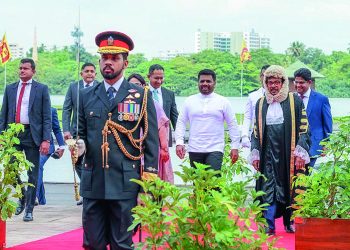On January 21st employees and representatives of the management of Pure Beverages, Trade Union leaders and the Labour Commissioner met in a renewed effort to resolve the long standing crisis at Pure Beverages (PB) company limited. The meeting concluded with the Labour Commissioner requesting the management of PB to submit certain proposals in an effort to resolve the worsening issue. The issue at stake is the continuing strike at PB which commenced on December 12th and remains unresolved up-to-date. The Trade Union action by 861 employees at PB erupted with the closure of PB’s factory at Kaduwela on November 26, 1996. Discussions on the issue and related matters have gone on for over 7 months, however, nothing has been resolved and the severity of the issue is evident in the major shortage of PB products in the country.
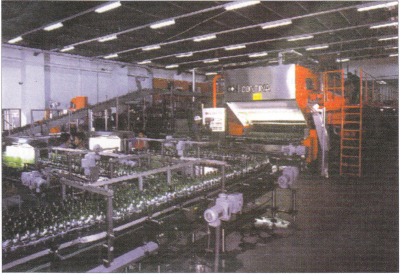
PB have been the bottlers for Coca Cola (CC) since 1966, under a franchise agreement with Coca Cola Export Corporation. The Company’s Headquarters is in Colombo, with two bottling plants in Kaduwela and Biyagama. In April 1961. Coca Cola was launched in Sri Lanka and in 1980 a new plant was opened in Kaduwela. In 1982.
Fanta Orange was launched in the country while Sprite was launched in 1984. In October 1988, the third bottling plant in Biyagama was commissioned. In September 1994, F & N Coca Cola Pvt Ltd., of Singapore, acquired 30 % equity of the company, pursuant to a deal made with the major shareholders of the company, with the right to appoint majority of the directors and to exercise certain management rights. F & N Coca Cola in- creased its equity in the company to 50.21%, by a direct offer made to all shareholders of the company. At present. F & N holds 82.71% of PB. According to the company’s Annual Report for 95/ 96. PB showed a loss of 8% for the year while turnover increased marginally to 1.3 billion rupees. In his review, the Chairman, WDM Fernando says, “the success of our business can be best illustrated by a simple statistic. It took 25 years before we increased production: capacity, by investing in a second bottling plant in Kaduwela. Since then, we have increased production capacity through investments in new bottling lines on an average of every five years. We have also changed from an independent bottler of CC to become a part of the global CC system through the acquisition of 82.74% of our shareholding by F & N Coca Cola Pvt.Ltd, the Singapore-based anchor bottler for CC. We are therefore well poised to meet the challenges of the future”. This report has no indication of either of the plants being over staffed nor any mention of the closure of the Kaduwela Plant. The first mention of a necessity to retrench the staff of PB was made on June 26, 1996 in a letter by the Employers Federation of Ceylon (EFC) (of whom PB is a member). The letter stated that the Management had decided to introduce a Voluntary Retirement scheme (VRS) in view of studies undertaken by PB, which have revealed that their plants are heavily overstaffed when compared to other plants in the entire Asian region. The letter was addressed to the General Secretary of Ceylon Mercantile Industrial and General Workers’ Union (CMU), which has the largest representation of PB workers. The CMU sent a reply two days later, calling for a clarification on two main matters. Firstly, what are the exact facts that reveal the local plants are heavily overstaffed compared to other plants in the region, and secondly what are the reduction levels that the company has in mind. The CMU however did not receive a reply to its letter Almost 6 weeks later the company arranged for a discussion with the CMU, through the EFC.
on August 14, 1996 at which the new GM, Frank Kendrick, appointed by F & N Coca Cola was present. According to a report by the General Secretary of the CMU. Bala Thampoe, Kendrick stated at the meeting that the studies said to have been carried out by PB had in fact been carried out by a team from the Atlanta Head Office of CC. No comparisons relating to other plants in Asia were put for- ward, however, the team had found from a study of the operations at Biyagama that unsatisfactory work practices called for reduction in the manning levels at the plant. The issue was to be dealt with by the CMU and the management of PB. These facts were endorsed in a letter sent by the EFC dated September 2, to the Gen. Sec. CMU, in which the problem at Biyagama was discussed. However, no mention of the Kaduwela factory was made. Thampoe’s report goes further to say that a discussion took place between the representatives of the CMU and Management of Biyagama on September 25, 1996. The Management representatives are reported to have acknowledged that the manning levels recorded by the Adanta team would not be sufficient to maintain continuous production at Biyagama. No further discussions took place between the Management and the employees till Octber 29th when, according to Thampoe, the decision to retrench 350 employees and to close down the Kaduwela factory was announced. The decision was conveyed to the CMU by a letter dated October 30, 1996, from the ERC The closure of the Kaduwela Plant. according to the letter, was being examined for some time, for three main reasons, namely:
1. Inadequate water supply at the plant
2. Environmental concerns regarding discharge of effluents and
3. High operation cost.
The decision on the closure without further delay was because of continuous massive losses and the poor response to the VRS scheme. This was the climax of the issue, and communication hence- forth centered only around one issue the initiation of strike action. The CMU in a letter sent the very same day, protested against the closure of the Kaduwela Factory and called for a reason for the sudden closure of the plant. Discussions followed on November 14, 1996 between the trade union officials and the Management when it was decided to extend the closure of the Kaduwela Factory to November 20, 1996. The CMU then replied protesting against the closure and inform the company of the temporary closure of the Biyagama Factory in order to permit workers to conduct a meeting to discuss the issue. This letter was followed by another letter warning of possible strike, action on December 12th if the Kaduwela Factory is not reopened. The communication between the two parties after this letter was as follows. On December15, 1996: PB wrote to the CMU saying they had applied to the Labour Commissioner to conduct an inquiry into the application to terminate the services of 350 employees. On December 9, 1996: PB wrote to CMU regretting trade union action and call for the matter to be dealt with by the relevant authorities. On December 12, 1996 CMU wrote to PB announcing trade union action.
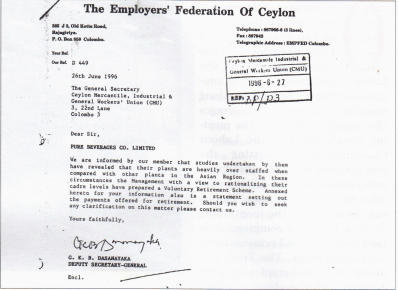
Thus on December 12th, 508 trade union workers and another 60 members of another trade union known as “the Food Beverages and Tobacco Industry Employees Union (FBTIU), went on strike in opposition to the closure of the Kaduwela Factory. The company reacted by writing to 293 employees of the CMU and FBTIU who laid out work at Kaduwela, requesting them to report to work at Biyagama from December 17th. This provoked the Union to call on all employees to join the strike The total number of workers currently on strike is 861. The matter has caused much concern amongst Labour Officials, International Unions and Business Officials. The public paid the biggest price with the strike, resulting in a complete shortage of PB products islandwide To critically analyze the issues that provoked the strike action certain important facts must be taken into consideration. Among them are:
1) Why was the Kaduwela plant closed down?
2) Why was the strike neglected at the inception?
3) What can be done to resolve the matter?
Ana Punchihewa. Managing Director of PB, says, the Kaduwela Factory was closed in an attempt to centralize operations and maximize exercise cost to guarantee the future health of the business.
“Kaduwela is no more economically viable as a soft drink production facility. It has inadequate infrastructure facilities for our future needs”. says Punchihewa. The CMU denies this fact and argues that the shut down of the Kaduwela Plant in November only took place when it became manifest to the decision makers of the company that the VRS had failed to achieve their objectives of a reduction in cadre levels. Bala Thampoe, goes further to explain that the shut down of the Kaduwela Plant amounted to a lock out of all workers of the plant in order to pressurise the workers and the union into accepting the retrenchment of 350 workers in the company.
They closed the factory when the VRS was not a success; only 80 people accepted it, so they closed Kaduwela and retrenched 350 employees Says Thampoe. that it Kaduwela was running at a loss why was is not mentioned in the company’s Annual Report and in The preliminary discussions last year. Punchihewa, however contradicts this. “The unions were aware of Pure Beverages Company’s financial situation and the need for restructuring says Punchihewa. “The decision to close Kaduwela was a business decision taken by the management to protect the future viability of the company”, he said. According to Thampoe, this is against the Trade Union Laws “No business decision can be taken without consulting the employees when it concerns the retrenchment of 350 workers”, says Thampoe.
Though the strike at Pure Beverages commenced on December 12th, the consequences of it was witnessed only in the latter part of December when Coca Cola products were unavailable in the market. The matter was suppressed in the business circles and hardly mentioned in the press. Reaction to the strike from both parties was also delayed to a great extent. The inquiry into the application to terminate the services of 350 employees continued through December to January. The first discussion on the strike action taken by employces was held on December 19h. with Trade Union Leaders, representatives of the Management of PB and the Minister of Labour and Vocational Trading Mahinda Rajapakse. The discussions ended in a dead lock. However, it was later reported that the Minister had requested the management of PB to re-open the factory and recommence discussion. It was also decided to meet again with the
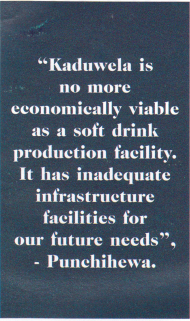
Labour Commissioner, on January 6th. At this meeting two Sri Lankan Human Resources Managers, representatives of the CMU and the Labour Commissioner were present. The company expresed its willingness to employ all the workers who were laid off at Kaduwela at Biyagama, as a temporary measure to meet the excess demand during the festive season. This proposal was rejected by the Union who insisted they would only call off the strike only if the Kaduwela factory is re-opened. The failure to resolve the issue resulted in another meeting fixed for January 15, 1997, which was later postponed to January 21,1997. During this period, PB made a public announcement requesting all workers to return to Biyagama and work there until the issue is resolved. On January 17th, workers met and took a unanimous decision not to agree to the proposition and to continue with the strike action. The Labour Commissioner Wimalasena, told “BusinessToday” that he had made a proposal to PB to open the Kaduwela factory and commence negotiations. However, he had received no response from them. On January 21st, all the parties met again in a renewed effort to resolve the matter. PB was represented by a new Human Resources Manager Samarasinghe, who prioritised the retrenchment of the workers as the issue at stake. Bala Thampoe representing the workers agreed to this but pointed out that the retrenchment was a result of the closure of the factory. The Labour Commissioner then called on PB’s Human Resources Manager to withdraw the application for the termination of the service of employees and discuss the issue with the unions. PB stood firm on the decision to keep the Kaduwela Plant closed but agreed to submit proposals on possible discussions on the issue of retrenchment. Both parties agreed to meet again on January 30th. Despite the discussions, the strike action launched by the employees of PB continues for over 6 weeks while CC products are virtually unseen in the market. Analysts point out that the loss suffered by PB is probably billions.
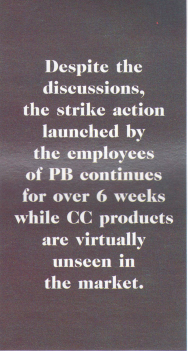
The issue has already claimed international attention. The International Union of Food, Agriculture, Hotel. Restaurant. Tobacco and the Allied Workers Association has written to both F & N, CC, Singapore and CC. Atlanta calling for the reopening of the Kaduwela factory and a speedy resolution to the matter. According to Punchihewa. PB. has received a letter from the International Union which has been acknowledged. The matter is now at an international level and has created much concern. Some analysts attribute the delay on the part of the management to resolve the issue as an attempt by F & N to run the company at a loss and buy
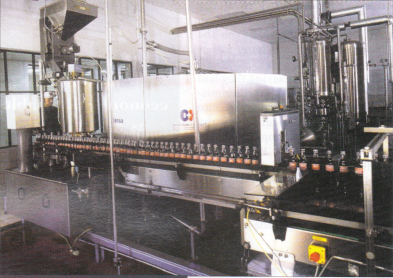
over the remaining shares, while others say it is an attempt by the Directors to appoint Ana Punchihewa as Chairman of the Company Punchihewa, in his interview with “Business Today” denied the latter view. However, the deadlock in negotiations has worsened the situation. The management of PB insist on continuing the closure of the Kaduwela Plant due to the heavy losses in running the Plant, which have resulted in the termination of the services of 350 employees. The employees meanwhile insist the closure of the factory is a result of the failure of
the VRS and has left 350 employees without jobs. The arguement of both parties are endless while efforts to reach a resolution on the matter has been a failure. The biggest appeal to recommence production at PB however, comes from the public, who want Coca Cola products to be brought back to the market, so that it can regain its position as the number one soft drink in Sri Lanka.


